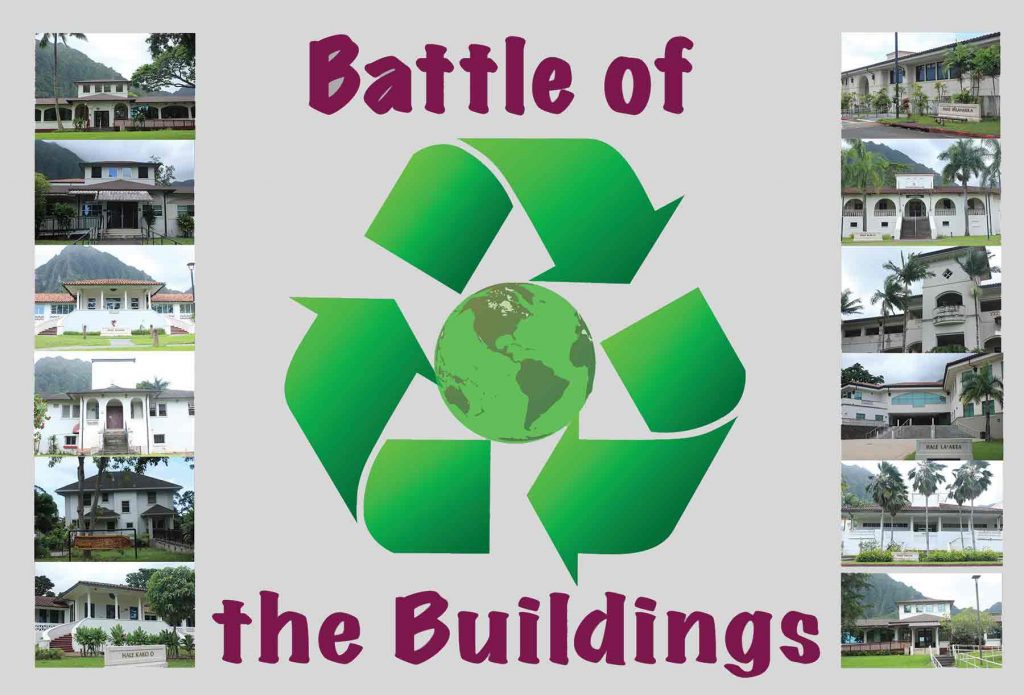
October kicks off WCC’s first-ever “Battle of the Buildings,” an energy conservation challenge that pits campus buildings against one another to see which can reduce its energy consumption the most.
The goal of the contest, which is loosely modeled off a national competition called Campus Conservation Nationals, is to help students, faculty and staff learn more about energy conservation and to use this knowledge to reduce their consumption.
Each building in the competition will have a team captain who will help the building’s residents develop an energy conservation plan. Because each building is so unique, the faculty, staff and students who use the buildings are the ones who know best what can be done to reduce their consumption.
Judging the competition will be tricky because each building is different in terms of size, what it’s used for and how the energy is used.
For example, ‘Ākoakoa and Pālanakila have chillers that are used to run the air conditioning in most of the buildings across campus while a handful of buildings have their own air conditioning systems.
In order to create a fair competition, the starting monthly energy usage for each building will be established and then adjusted based on whether or not they are part of the centrally controlled air conditioning. From that baseline, each building will be measured on its percent reduction rather than its overall energy usage to control for the different sizes and energy needs of the different buildings. Each building will try to do better than its baseline rather than simply competing against other buildings for reduction in total kilowatt hours.
Winners will be announced each month until the end of the academic year. In addition, there will be semester winners and a grand prize for the building with the greatest energy reduction by the end of the year.
In order to help teams better document their energy usage, they can use smartsockets, which are devices that can be plugged in between an appliance and the socket to measure the total energy use flowing out the socket and then communicating the data to a computer program.
The sockets can also be programmed to shut off different appliances at certain times of the day. Teams can use smart sockets strategically to understand how different appliances might affect their building’s energy usage.
All of the energy usage data that is being used to run the competition is generated by Johnson Controls Inc., an energy management firm that is partnering with a number of campuses across the University of Hawai‘i system to reduce energy usage. The company has installed submeters in most of the buildings at WCC to monitor their energy usage and will be providing the data to document the energy savings from different building’s plans.
The Battle of the Building is part of a larger push at WCC to be a model of sustainability within the UH system and surrounding community. Although there are many definitions of sustainability, the concept emphasizes the need for institutions to move beyond simply thinking about finances to simultaneously addressing the triple bottom line of people, planet and profit.
Recently, the college approved a sustainability plan that addresses diverse issues such as curriculum, research, community outreach, cultural connections, as well as the day-to-day operations of the University. In addition, this fall, a campus-wide sustainability committee is being established to encourage more sustainability initiatives on campus and help support the implementation of our campus plan.
The Battle of the Buildings is one of the first of these initiatives that will help reduce the campus’s carbon footprint and energy consumption, while saving money that can be put to better use.
Research estimates that informing consumers about their energy usage can reduce energy consumption from 4 to 12 percent, a significant savings for an institution like WCC. These savings come from behavioral changes as people become more educated about energy conservation.
by Christian Palmer, Special to Ka ‘Ohana




